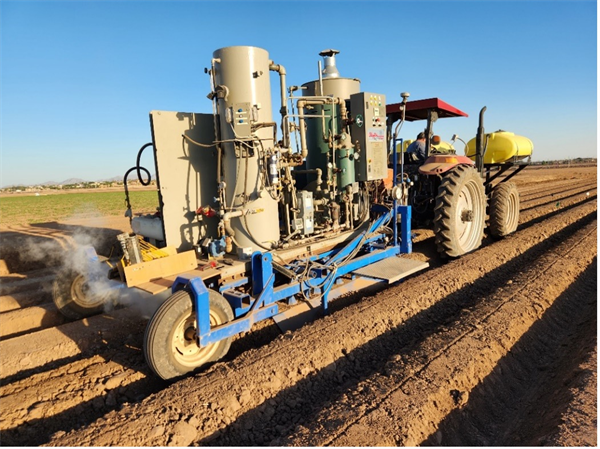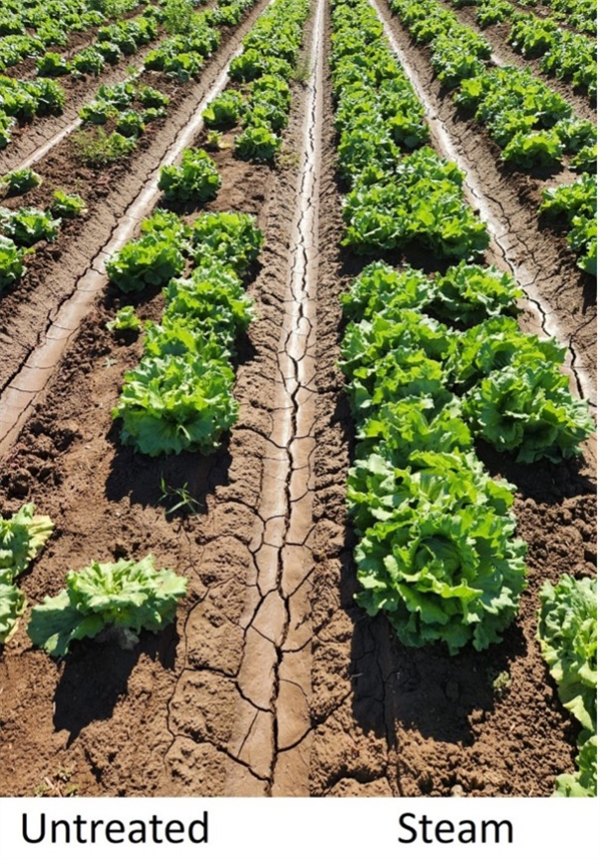
At events and in the halls of the Yuma Agricultural Center, I’ve been hearing murmurings predicting a wet winter this year…
As the Yuma Sun reported last week, “The storms of Monday, Aug. 25 [2025], were the severest conditions of monsoon season so far this year in Yuma County, bringing record-rainfall, widespread power outages and--in the fields--disruptions in planting schedules.”
While the Climate Prediction Center of the National Weather Service maintains its prediction of below average rainfall this fall and winter as a whole, the NWS is saying this week will bring several chances of scattered storms.
These unusually wet conditions at germination can favor seedling disease development. Please be on the lookout for seedling disease in all crops as we begin the fall planting season. Most often the many fungal and oomycete pathogens that cause seedling disease strike before or soon after seedlings emerge, causing what we call damping-off. These common soilborne diseases can quickly kill germinating seeds and young plants and leave stands looking patchy or empty. Early symptoms include poor germination, water-soaked or severely discolored lesions near the soil line, and sudden seedling collapse followed by desiccation.
It is important to note that oomycete and fungal pathogens typically cannot be controlled by the same fungicidal mode of action. That is why an accurate diagnosis is critical before considering treatments with fungicides. If you suspect you have seedling diseases in your field, please submit samples to the Yuma Plant Health Clinic or schedule a field visit with me.
National Weather Service Climate Prediction Center: https://www.cpc.ncep.noaa.gov/
National Weather Service forecast: https://forecast.weather.govIn a prior article (Vol. 14, Issue 19), I discussed the initiation of a fall 2023 trial examining the use of band steam for controlling Fusarium wilt of lettuce. Again, the premise behind the research is to use steam heat to raise soil temperatures to levels sufficient to kill soilborne pathogens. For Fusarium oxysporum f. sp. lactucae (FOL) the pathogen which causes Fusarium wilt of lettuce, the required temperature for control is generally taken to be > 140°F for 20 minutes. Soil solarization, where clear plastic is placed over the crop bed during the summer, exploits this concept. The technique raises soil surface temperatures to 150-155˚F, effectively killing the pathogen and reducing FOL disease incidence by 45-98% (Matheron and Porchas, 2010).
In our trials, we used steam heat to raise soil temperatures. Steam was delivered by a 35 BHP steam generator mounted on a custom designed elongated bed shaper (Fig. 1). As the device traveled through the field, steam was injected into the soil in narrow bands centered on the seedline. Four band sizes ranging from 4” wide x 2” deep to 6” wide by 4” deep were examined to determine the optimal width and depth of the band of soil that needs to be disinfested to prevent disease. Travel speed was 0.2 mph and soil temperatures were raised to about 190°F. After cooling (< ½ a day), the crop (FOL susceptible iceberg lettuce variety El Guapo) was planted into the disinfested soil.
Preliminary results are very encouraging (Table 1, Fig. 2). The percentage of diseased plants was roughly four times lower in steam treated plots as compared to the untreated plots at the first evaluation date, 39 days after planting (DAP) (19% vs ~ 5%), and about two times lower at the second evaluation date, 60 DAP (32% vs ~17%). These results are consistent with our previous studies which showed that in soils that have moderate FOL inoculum levels, steam treatment reduced disease incidence at maturity by more than 40%. A surprising result was that the width and depth of soil steam treatment did not have a significant effect on disease incidence. A logical explanation for this result could not be formulated as one would expect disease incidence to be reduced if a larger volume of soil is disinfested.
Stay tuned for final trial results!
On a slightly different note, if you are interested in seeing the plots, I will be at the field site Field Day this Wednesday, November 30th from 8:00 am-12:00 pm. The location is the JV Farms Fusarium Trial site, located off of Hwy 95 and Ave 5E (32.6920898, -114.5395051).
Hope to see you there!
References
Matheron, M. E., & Porchas, M. 2010. Evaluation of soil solarization and flooding as management tools for Fusarium wilt of lettuce. Plant Dis. 94:1323-1328.
Acknowledgements
This project is sponsored by USDA-NIFA, the Arizona Specialty Crop Block Grant Program and the Arizona Iceberg Lettuce Research Council. We greatly appreciate their support.
A special thank you is extended to Fatima Corona, Pablo Delgado, Chad VanMatre, Matt McGuire and JV Farms for their generous assistance and allowing us to conduct this research on their farm.
|
Table 1. Effect of band-steam on Fusarium wilt of lettuce disease incidence in a trial conducted with iceberg lettuce in Yuma, AZ in 2023. |
||
|
|
----------------- Disease Incidence, % ----------------- |
|
|
Treatment1 |
39 DAP2 |
60 DAP |
|
Band-steam: 4”x2” |
2.4 |
17.5 |
|
Band-steam: 4”x4” |
5.0 |
15.0 |
|
Band-steam: 6”x2” |
8.5 |
22.4 |
|
Band-steam: 6”x4” |
3.8 |
16.4 |
|
Untreated |
19.2 |
32.1 |
|
1Dimensions for band-steam treatments indicate the width and depth of the band of soil that was treated with steam. |
||

Fig. 1. Band-steam applicator principally comprising a 35 BHP steam generator
mounted on a bed-shaper applicator sled. The device injects steam into the soil
as beds are formed.

Fig. 2. Fusarium wilt of lettuce control with band-steam in iceberg
lettuce. Steam was applied in a narrow band (4” wide x 4” deep)
centered on the seedline prior to planting. After the soil cooled (< 1/2
day), the crop was planted into the disinfested soil.
In the absence of Dacthal (DCPA) growers are looking for different herbicide options for Broccoli and Onions.
The following is data from a broccoli trial done in 2010 by Tickes/Pena, which compares Prowl, Goal Tender, Prefar, Treflan, Devrinol and Dacthal at different application timings. Plots were visually evaluated for weed control of Goosefoot (Chenopodium murale), Malva (Malva parviflora), and Yellow Sweet Clover (Melilotus oficinalis). The label recommendations for Devrinol are “Use the lower rate on light soil (coarse textured-sandy), and the higher rate on heavy soil (fine textured-clay)”. The rate goes from 1-2 lbs on the DF-XT 50% formulation.
We hope this information is useful in our decision making for broccoli herbicide programs.
Results of pheromone and sticky trap catches can be viewed here.
Corn earworm: CEW moth counts down in most over the last month, but increased activity in Wellton and Tacna in the past week; above average for this time of season.
Beet armyworm: Moth trap counts increased in most areas, above average for this time of the year.
Cabbage looper: Moths remain in all traps in the past 2 weeks, and average for this time of the season.
Diamondback moth: Adults decreased to all locations but still remain active in Wellton and the N. Yuma Valley. Overall, below average for January.
Whitefly: Adult movement remains low in all areas, consistent with previous years.
Thrips: Thrips adults movement decreased in past 2 weeks, overall activity below average for January.
Aphids: Winged aphids are still actively moving, but lower in most areas. About average for January.
Leafminers: Adult activity down in most locations, below average for this time of season.